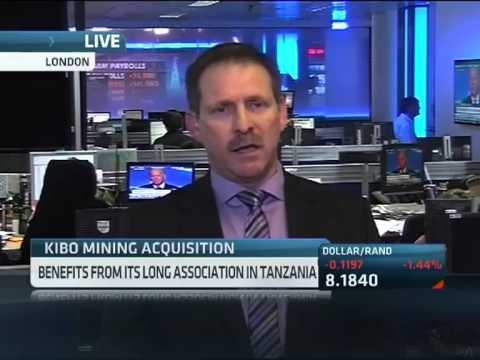Rukwa Definitive Mining Feasibility Study London Stock Exchange
Post on: 19 Июнь, 2015 No Comment


Kibo   Mining   Plc   (Incorporated   in   Ireland)
(Registration   Number:   451931)
(External   registration   number:   2011/007371/10)
Share   code   on   the   JSE   Limited: KBO  
Rukwa Definitive Mining Feasibility Study — Phase 1, Stage 1 Report Findings
Kibo Mining plc (Kibo or the Company) (AIM: KIBO; AltX: KBO), the Tanzania focussed mineral exploration and development company, is pleased to announce the findings from Phase 1, Stage 1 of the Company commissioned Definitive Mining Feasibility Study (DMFS), concerning the mining element of the Rukwa Coal to Power Project (RCPP). The Executive Summary of the DMFS Phase 1, Stage 1 Report is available on Kibo’s website at www.kibomining.com.
Key highlights
-     Four alternative options identified for project development with the project financially feasible for all of the options investigated;
-     Annual estimated coal sale revenues of between US$39million and US$43million assuming annual sales 1.6m tonnes;
-     All-in Cost Margin ranges from 38% to 45%. Applying the aforementioned All — in Cost Margin, Kibo interprets that an annual margin of between US$14.8 million to $19.4 million will be generated;
-     Applying a real discount rate of 5.7% the best estimated Net Present Value ranges from US$116million to US$141million.
Louis Coetzee, CEO of Kibo Mining, said We are delighted to deliver this DMFS update to investors.  The report is highly significant in numerous areas but notably in respect of the All-in Cost Margin range of 38% to 45%, which is significantly above the 25% level considered healthy for this type of project.    
We are also delighted with the estimated Net Present Value range of US$116million to US$141million, which demonstrates the value of just one component of Kibo Mining’s assets. 
The All-in Cost Margin and Net Present Value ranges are particularly impressive given the very prudent assumptions applied.  This is evidenced by the use of coal pricing significantly below the current market price reflecting the robust economies of this project as well as the prudent initial DMFS assumptions.  As a result, this represents a base case valuation for the project. 
Furthermore, we would note that this valuation, pertaining as it does to the coal mining element of the RCPP, is solely in respect of an input (i.e. coal supply) to power generation.  The power element is expected to be considerably more substantial in terms of operational revenues and its proportionate significance in respect of the economic potential of the RCPP. 
We expect receipt of the final Power Pre-Feasibility Study shortly and will update investors on the report and its findings when received.
Important Notes for Readers:
The information contained within this report is taken from the DMFS Phase 1, Stage 1 report produced by Minxcon Projects in respect of the RCPP. Recognising the level of commercial sensitivity and for the protection of all stakeholders’ interests we have limited the technical information that we publish in this report and in the wider public domain at this time. 
Readers must note that operational and financial data pertaining to any complex development project of this nature is project specific. Kibo has undertaken the RCPP DMFS to properly and professionally understand the technical and financial merits of the project. The findings outlined can only be used in an assessment and analysis of the RCPP to which this work relates and not as a generic benchmark standard.
Further information with regard to the RCPP and a copy of the Executive Summary of the DMFS Phase 1, Stage 1 report is available on the Company’s website at www.kibomining.com . 
DMFS Phase 1, Stage 1 — Executive Summary Extracts and Commentary
The Definitive Mining Feasibility Study — Rukwa Coal to Power Project:
Minxcon (Pty) Ltd (Minxcon) was commissioned by Kibo Mining Plc (Kibo or the Client) to compile a Definitive Mining Feasibility Study (DMFS) on the Rukwa Coal to Power Project (RCPP or Project). The intended Rukwa Coal Mine is located in south-western Tanzania, approximately 70 km northwest of the regional capital of Mbeya. This Report forms part of the total DMFS which aims to design and plan the establishment and construction of the Rukwa Coal Mine.
DMFS Deliverable:
The main deliverable of Phase 1, Stage 1 of the DMFS, the Concept Study Report is a report providing an independent assessment on an order of magnitude level of detail. Execution of the Concept Study forms part of an integrated project development process for the RCPP and is informed by the independent technical report on the Rukwa Coal Resource, as well as the information contained in the RCPP Information Memorandum (Summary of Investment Opportunity). In the Concept Study Report Minxcon made important recommendations to assist Kibo to complete the Definitive Mining Feasibility Study (DMFS) to an appropriate level of detail.
Financial summary:
-     four alternative options identified for project development (the financial data ranges that follow are dependent on which of the project development options is selected);
-     the Project is financially feasible for all of the options investigated;
-     the Project has been currently assessed over a 27 year mine life, with an average annual coal production of 1.48million tonnes over the life of mine;
-     annual coal sale revenues are estimated at US$37million to US$44million;
-     the All-in Cost Margin ranges from 38% to 45% of revenue;
-     All-in Cost Margin ranges from 38% to 45%. Applying the aforementioned All — in Cost Margin, Kibo interprets that an annual margin of between US$14.8 million to $19.4 million will be generated;
-     high All-in Cost Margin reflects low operating costs as a result of the proposed mining method and shallow ore body, small sustaining capital expenditure and fixed coal price as received from the power plant;
-     the high all-in cost margin is an indication of the robustness of the Project;
-     capital investment of between US$46 million and US$89 million;
-     payback period for the Project is estimated at between 3.9 and 4.7 years;
-     applying a real discount rate of 5.7% the best estimated Net Present Value ranges from US$116 million to US$141 million.
Coal Mineral Resource:

Mineral Resource classification and reporting has been conducted in accordance with the requirements of NI 43-101 by Geological Exploration Mining Evaluation Consulting Services (Pty) Limited (GEMECS) who has reviewed the coal properties in accordance to the terms, definitions and guidelines provided in A Standardized Coal Resource/Reserve Reporting System for Canada. The estimated Coal Inferred and Indicated Mineral Resources are outlined in the ‘Rukwa Mineral Resource Section’ outlined underneath the ‘Notes for Editors’ section below.
Capital Footprint and Battery Limits:
The Capital Footprint and Battery Limits for the mine and plant includes the opencast pit, mining and processing equipment, mining and plant buildings, all mining stockpiles, coal product conveyor to power plant, electrical supply to and reticulation within the mine and plant area, excess water pipeline to power plant, staff accommodation and communication systems to and reticulation within the mine and plant area.  The power plant’s Battery Limits (excluded from Minxcon’s Battery Limits) include everything inside their security fence or boundary, electrical power lines, ash storage dams as well as a water line from Lake Rukwa.  The mine will be responsible for the construction of all items that fall within its capital footprint as well as various infrastructure leading up to the new envisioned power plant.
Mining and Processing Options:
Four different options were investigated during the mining concept study, which will be further analysed in Phase 2 of Stage 1 of the DMFS. The differences in the 4 options are mainly applicable to alterations in mining operating costs and mining capital costs, as well as 2 different plant options.  
Option 1 (Contractor Mining, Crusher-Only);
Option 2 (Contractor Mining, De-stoning Plant);
Option 3 (Owner Operated Mining, De-stoning Plant); and
Option 4 (Surface Miner, De-stoning Plant excl Crusher).
All these options described above were valued through Minxcon’s discounted cash flow (DCF) model to demonstrate the viability and justifiability of extraction of coal under a defined set of realistically-assumed modifying factors.
There exist 7 different coal seams for the Rukwa Coal Mine.  It is clear that a constant coal production over the total Life of Mine (LoM) can be achieved.
Capital Expenditure:
All costs were sourced from actual quotations as provided by the Original Equipment Manufacturers (OEMs) and/or from retail companies. Where quotations could not be sourced, historical costs and quotations were escalated to align with the current financial year and market inflation figures. Detail about the capital is described in the relevant mining and plant reports.
It was assumed that the fleet would be replaced every five years at 70% of original fleet cost in the capital schedule for Option 3 and Option 4.
Discounted Cash Flow Modelling:
In generating the financial model and deriving the valuations, the Free Cash Flow to Company — DCF valuation was set up in calendar years ending December. A discount rate of 5.73% (in real terms) was calculated for the discount factor, but the NPV was also shown for a range of discount rates. The full intrinsic value of the operation was reported — no attributable value was calculated. The coal prices were sourced from the client and are based on the expected price Rukwa will receive from the power plant that would start operations in parallel with the mine. For the purpose of the financial model the coal prices were constant throughout the LoM.
Project Key Risks:
The business of mining and mineral exploration and production by their nature contain significant operational risks.  The business depends upon, amongst other things, successful prospecting programmes and competent management.  Profitability and asset values can be affected by unforeseen changes in operating circumstances and technical issues. 
Factors such as political and industrial disruption, currency fluctuation and interest rates could have an impact on future operations, and potential revenue streams can also be affected by these factors.  The majority of these factors are, and will be, beyond the control of any operating entity. 
The Project is identified as being most sensitive to the coal price and operating costs.














